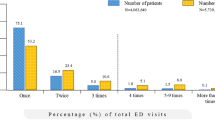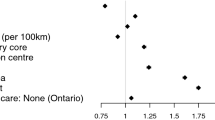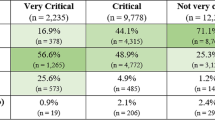Abstract
Approximately 520,000 residents (30 % Bedouins) inhabit the Negev region of southern Israel. Despite the geographical proximity, Bedouins differ from Jews demographically and socio-economically. To evaluate the ethnic disparities in emergency department (ED) utilization patterns in this population-based observational retrospective cohort study, individual data regarding 93,338 visits to the ED throughout 2007–2009 (9 months) were obtained. Demographic data were obtained from the Central Bureau of Statistics. The age- and gender-adjusted annual rates of ED visits were: 31.1 and 23 per 100 residents for Bedouins and Jews, respectively (P < 0.001). Significant differences in visiting patterns according to the weekday and time of day between these groups were observed. Bedouins were referred at a higher rate by a physician compared with Jews (81 vs. 61 %; P < 0.001). Ethnic disparities in chief complaints including the following age-adjusted odds ratio values of Bedouins compared with Jews were found: respiratory [Adj OR 1.38 (95 % CI 1.31–1.46)], fever [Adj OR 0.67 (95 % CI 0.64–0.71)], and cardiovascular [Adj OR 1.23 (95 % CI 1.16–1.32)] in Bedouins versus Jews, respectively (P < 0.001 each). Multivariate analysis demonstrated a higher risk for in-hospital admission among Bedouins than Jews [Adj OR 1.52 (95 % CI 1.47–1.58); P < 0.001]. Utilization patterns of EDs of Bedouins and Jews differ. Potential etiologies are increased morbidity, reduced accessibility to primary care clinics, use of private often non-board-certified physicians, and decreased socio-economic status among Bedouins. This warrants further research and interventional programs dealing with causes of the disparities.





Similar content being viewed by others
References
Trzeciak S, Rivers EP (2003) Emergency department overcrowding in the United States: an emerging threat to patient safety and public health. Emer Med J 20:402–405
Nakar S, Vinker S, Or Y, Schadel M, Niego Y, Plotkin G (1999) Referrals to an emergency department: are there differences between self-referrals and referrals from general practitioners? Harefuah 137:603–606
Murphy AW (1998) ‘Inappropriate’ attenders at accident and emergency departments I: definition, incidence and reasons for attendance. Fam Pract 15:23–32
Niska R, Bhuiya F, Xu J (2010) National Hospital Ambulatory Medical Care Survey: 2007 emergency department summary. Natl Health Stat Report 6:1–31
Burt CW, McCaig LF (2001) Trends in hospital emergency department utilization: United States, 1992–99. Vital Health Stat 13(150):1–34
Brown EM, Goel V (1994) Factors related to emergency department use: results from the Ontario Health Survey 1990. Ann Emerg Med 24:1083–1091
Israel Ministry of Health, official website. http://www.old.health.gov.il. Accessed 29 February 2012
The Negev Development Authority (2004) Statistical Yearbook of the Negev. Beer-Sheva
Tamir O, Peleg R, Dreiher J, Abu-Hammad T, Rabia YA, Rashid MA, Eisenberg A, Sibersky D, Kazanovich A, Khalil E, Vardy D, Shvartzman P (2007) Cardiovascular risk factors in the Bedouin population: management and compliance. Isr Med Assoc J 9:652–655
Plakht Y, Gilutz H, Shiyovich A, Zahger D, Weitzman S (2011) Gender and ethnic disparities in outcome following acute myocardial infarction among Bedouins and Jews in Southern Israel. Eur J Public Health 21:74–80
Kokkonen S (2002) The Bedouins of the Negev confront a modern society. World Zionist Organization Hagshama Department; October 31
The Negev is the Southern region of Israel and is an ideal location for implementing community intervention programmes for populations in transition (2008) Oxford Health Alliance
Carmel S, Anson O, Levin M (1990) Emergency department utilization by two subcultures in the same geographical region. Soc Sci Med 31:557–563
Livnat S, Almog E, Robinowitch G, Sner Y (2000) Ethnicity and emergency department visits in the Negev. Harefuah 138:631–634
Cohen AD, Dreiher J, Sharf A, Vardy DA (2007) Utilization of emergency department services by the Bedouin population in Southern Israel. Sci World J 7:330–335
Israel Central Bureau of Statistics, official website. http://www.cbs.gov.il/reader/?MIval=cw_usr_view_Folder&ID=141. Accessed 25 Jan 2012
Keyfitz N (1966) Sampling variance of standardized mortality rates. Hum Biol 38:309–317
Takashi YT, Fujii Y (1990) Homogeneity test with a generalized Mantel–Haenszel Estimator for L2 × K contingency tables. J Am Stat Assoc 85:744–748
Hunt KA, Weber EJ, Showstack JA, Colby DC, Callaham ML (2006) Characteristics of frequent users of emergency departments. Ann Emerg Med 48:1–8
Borkan JM, Morad M, Shvarts S (2000) Universal health care? The views of Negev Bedouin Arabs on health services. Health Policy Plan 15:207–216
Elnekave E, Gross R (2004) The health experiences of Arab Israeli women in a reformed health care system. Health Policy 69:101–116
Bilenko N, Hammel R, Belmaker I (2007) Utilization of antenatal care services by a semi-nomadic Bedouin Arab population: evaluation of the impact of a local Maternal and Child Health Clinic. Matern Child Health J 11:425–430
Richardson LD, BabcockIrvin C, Tamayo-Sarver JH (2003) Racial and ethnic disparities in the clinical practice of emergency medicine. Acad Emerg Med 10:1184–1188
Flores G (2006) Language barriers to health care in the United States. N Engl J Med 355:229–231
Keinan-Boker L, Noyman N, Chinich A, Green MS, Nitzan-Kaluski D (2005) Overweight and obesity prevalence in Israel: findings of the first national health and nutrition survey (MABAT). Isr Med Assoc J 7:219–223
Baron-Epel O, Haviv-Messika A, Tamir D, Nitzan-Kaluski D, Green M (2004) Multiethnic differences in smoking in Israel: pooled analysis from three national surveys. Eur J Pub Health 14:384–389
Brodsky J, Schnoor Y, Be’er S (2006) The elderly in Israel: The 2005 statistical abstract. Jerusalem: Mashav—planning for the Elderly: A National Data Base (shared by JDC-Brookdale Institute of Gerontology and Human Development, and Eshel—The Association for the Planning and Development of Services for the Aged in Israel)
Azaiza F, Brodsky J (2003) The aging of Israel’s Arab population: needs, existing responses, and dilemmas in the development of services for a society in transition. Isr Med Assoc J 5:383–386
Na’amnih W, Muhsen K, Tarabeia J, Saabneh A, Green MS (2010) Trends in the gap in life expectancy between Arabs and Jews in Israel between 1975 and 2004. Int J Epidemiol 39:1324–1332
Gofin R, Avitzour M (2007) Use of pre-hospitalization services in two population groups of injured children and adolescents in Israel. Isr Med Assoc J 9:724–728
Weitzman D, Shoham-Vardi I, Elbedour K, Belmaker I, Siton Y, Carmi R (2000) Factors affecting the use of prenatal testing for fetal anomalies in a traditional society. Community Genet 3:61–70
Morad M, Shvarts S, Merrick J, Borkan J (2006) The influence of Israel Health Insurance Law on the Negev Bedouin population—a survey study. Sci World J 6:81–95
LaCalle E, Rabin E (2010) Frequent users of emergency departments: the myths, the data, and the policy implications. Ann Emerg Med 56:42–48
Pines JM, Russell Localio A, Hollander JE (2009) Racial disparities in emergency department length of stay for admitted patients in the United States. Acad Emerg Med 16:403–410
Bekmezian A, Chung PJ, Cabana MD, Maselli JH, Hilton JF, Hersh AL (2011) Factors associated with prolonged emergency department length of stay for admitted children. Pediatr Emerg Care 27:110–115
Conflict of interest
None.
Author information
Authors and Affiliations
Corresponding author
Rights and permissions
About this article
Cite this article
Plakht, Y., Abu Tailakh, M., Barabi, T. et al. Ethnic disparities in emergency department utilization patterns in southern Israel: a population-based study. Intern Emerg Med 7, 547–555 (2012). https://doi.org/10.1007/s11739-012-0835-4
Received:
Accepted:
Published:
Issue Date:
DOI: https://doi.org/10.1007/s11739-012-0835-4




